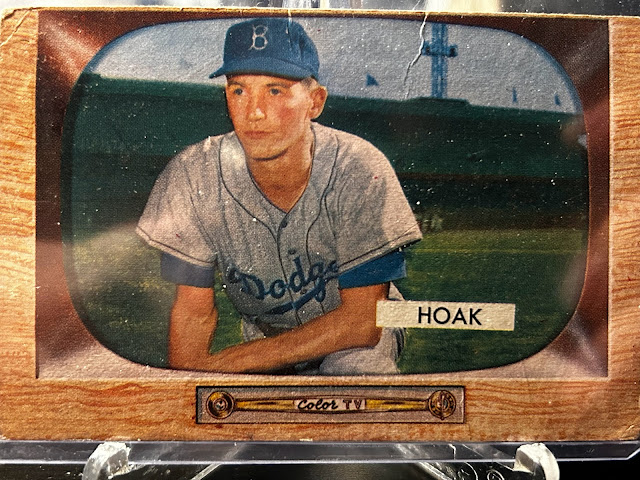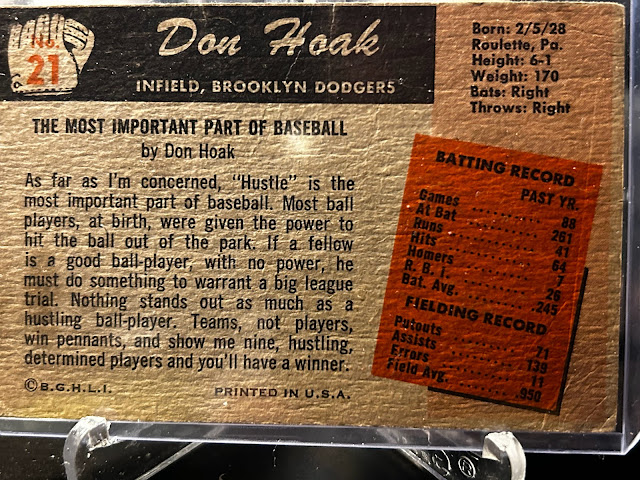Just looking at Hoak's major league stats, you might think he came to baseball later than others of the era. Hoak broke in with the Brooklyn Dodgers in 1954 at the "ripe old" age of 26. However, he had been toiling away in the Dodgers minor league system since 1947 (after a 2-year stint with the Navy as well).
Sidetrack: most of the cards we've seen so far have looked like actual photographs of the players over a background painting. Something about Houk's card has an "uncanny valley" feel to it. As though the uniform was painted on over the top of a different picture. I'll spoil the fact that my next subject is one that's obviously a painting, and not a very good one.
In his two seasons with the Dodgers, he split time with Jackie Robinson at third base. That's a tough act to break into, but Houk performed decently well. In fact, he was the third baseman when the Dodgers won Game 7 over the New York Yankees - the only postseason game in Jackie Robinson's career that he wasn't on the field.
After that series, Houk was traded to the Cubs, where he struggled mightily in 1956. Houk hit just .215 in his season in Chicago. He also became the first (and possibly still only) player to strike out 6 times in a single game against 6 different pitchers.
Houk was then shipped to Cincinnati where he had his only All-Star appearance in his career in 1957. He hit 39 doubles that season to lead the league.
After a less successful 1958 season, he was traded to the Pirates. Here, he finished in the Top 20 for MVP votes twice, including the runner up spot in 1960. He also won his second World Series ring with the Pirates in 1960.
After a less than stellar 1962 season, Houk was traded to the Phillies. In 1964, after 6 appearances without a hit, Houk was released by the Phillies and he never played baseball again at the age of 36.
It's hard to argue that "hustle" is one of the most important parts of baseball.
After his playing days were over, Houk was a broadcaster for the Pirates for two seasons. He then became a coach for the Phillies. Houk eventually settled down and became a successful minor league manager in the Pirates organization.
After the 1969 season, the Pirates major league team was needing a new manager. Houk believed that after a couple very good seasons as the manager of the AAA Columbus Jets, that he would be the next manager. Instead, the Pirates re-hired Danny Murtaugh for his third stint with the team. To be fair, Murtaugh was the manager for the 1960 team, so he had a good history with the team. Unfortunately for Houk, he was very crestfallen by this news.
Just a couple hours after he was told the bad news, Houk looked outside and saw someone trying to steal his brother-in-law's car. Houk ran out to his car to give chase. During the chase, Houk suffered a massive heart attack, and eventually passed away. Houk's wife, actress Jill Corey, said Houk actually died of a broken heart. He was 41 years old. Houk was cremated, and his ashes are buried in tiny Fishing Creek Cemetery just outside his hometown of Roulette, Pennsylvania.


Comments
Post a Comment